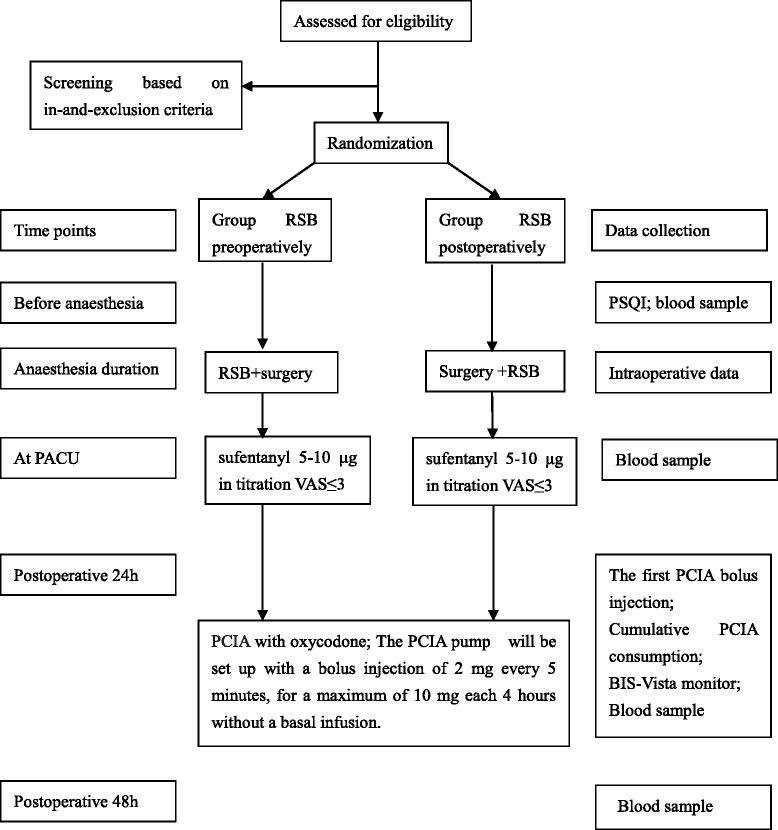Preoperative versus postoperative ultrasound-guided rectus sheath block for improving pain, sleep quality and cytokine levels of patients with open midline incisions undergoing transabdominal gynaecological operation: study protocol for a randomised controlled trial
- PMID: 26652009
- PMCID: PMC4676186
- DOI: 10.1186/s13063-015-1096-0
Preoperative versus postoperative ultrasound-guided rectus sheath block for improving pain, sleep quality and cytokine levels of patients with open midline incisions undergoing transabdominal gynaecological operation: study protocol for a randomised controlled trial
Abstract
Background: Rectus sheath block (RSB) is used for postoperative pain relief in patients undergoing abdominal surgery with midline incision. Preoperative RSB has been shown to be effective, but it has not been compared with postoperative RSB. The aim of the present study is to evaluate postoperative pain, sleep quality and changes in the cytokine levels of patients undergoing gynaecological surgery with RSB performed preoperatively versus postoperatively.
Methods/design: This study is a prospective, randomised, controlled (randomised, parallel group, concealed allocation), single-blinded trial. All patients undergoing transabdominal gynaecological surgery will be randomised 1:1 to the treatment intervention with general anaesthesia as an adjunct to preoperative or postoperative RSB. The objective of the trial is to evaluate postoperative pain, sleep quality and changes in the cytokine levels of patients undergoing gynaecological surgery with RSB performed preoperatively (n = 32) versus postoperatively (n = 32). All of the patients, irrespective of group allocation, will receive patient-controlled intravenous analgesia (PCIA) with oxycodone. The primary objective is to compare the interval between leaving the post-anaesthesia care unit and receiving the first PCIA bolus injection on the first postoperative night between patients who receive preoperative versus postoperative RSB. The secondary objectives will be to compare (1) cumulative oxycodone consumption at 24 hours after surgery; (2) postoperative sleep quality, as measured using a BIS-Vista monitor during the first night after surgery; and (3) cytokine levels (interleukin-1, interleukin-6, tumour necrosis factor-α and interferon-γ) during surgery and at 24 and 48 hours postoperatively.
Discussion: Clinical experience has suggested that RSB is a very effective postoperative analgesic technique, and we will answer the following questions with this trial. Do preoperative block and postoperative block have the same duration of analgesic effects? Can postoperative block extend the analgesic time? The results of this study could have actual clinical applications that could help to reduce postoperative pain and shorten hospital stays.
Trial registration: Current Controlled Trials NCT02477098 15 June 2015.
Figures
Similar articles
-
Preoperative versus postoperative ultrasound-guided rectus sheath block for improving pain, sleep quality and cytokine levels in patients with open midline incisions undergoing transabdominal gynecological surgery: a randomized-controlled trial.BMC Anesthesiol. 2018 Feb 9;18(1):19. doi: 10.1186/s12871-018-0485-9. BMC Anesthesiol. 2018. Retraction in: BMC Anesthesiol. 2021 Sep 23;21(1):230. doi: 10.1186/s12871-021-01437-z. PMID: 29426287 Free PMC article. Retracted. Clinical Trial.
-
The analgesic efficacy of subcostal transversus abdominis plane block compared with thoracic epidural analgesia and intravenous opioid analgesia after radical gastrectomy.Anesth Analg. 2013 Aug;117(2):507-13. doi: 10.1213/ANE.0b013e318297fcee. Epub 2013 Jun 6. Anesth Analg. 2013. PMID: 23744953 Clinical Trial.
-
Transversus abdominis plane block versus perioperative intravenous lidocaine versus patient-controlled intravenous morphine for postoperative pain control after laparoscopic colorectal surgery: study protocol for a prospective, randomized, double-blind controlled clinical trial.Trials. 2014 Dec 4;15:476. doi: 10.1186/1745-6215-15-476. Trials. 2014. PMID: 25472808 Free PMC article. Clinical Trial.
-
Intra-operative paravertebral block for postoperative analgesia in thoracotomy patients: a randomized, double-blind, placebo-controlled study.Eur J Cardiothorac Surg. 2011 Oct;40(4):902-6. doi: 10.1016/j.ejcts.2011.01.067. Epub 2011 Mar 5. Eur J Cardiothorac Surg. 2011. PMID: 21377888 Review.
-
Efficacy and Safety Profile of Rectus Sheath Block in Adult Laparoscopic Surgery: A Meta-analysis.J Surg Res. 2021 May;261:10-17. doi: 10.1016/j.jss.2020.12.003. Epub 2020 Dec 30. J Surg Res. 2021. PMID: 33387729
Cited by
-
Rectus sheath block for postoperative analgesia in patients with mesenteric vascular occlusion undergoing laparotomy: A randomized single-blinded study.Anesth Essays Res. 2016 Sep-Dec;10(3):516-520. doi: 10.4103/0259-1162.179315. Anesth Essays Res. 2016. PMID: 27746544 Free PMC article.
-
A randomized placebo-controlled double-blind study of dexmedetomidine on postoperative sleep quality in patients with endoscopic sinus surgery.BMC Anesthesiol. 2022 Jun 1;22(1):172. doi: 10.1186/s12871-022-01711-8. BMC Anesthesiol. 2022. PMID: 35650554 Free PMC article. Clinical Trial.
-
Effect of ultrasound-guided continuous erector spinae plane block on postoperative pain and inflammatory response in patients undergoing modified radical mastectomy for breast cancer: study protocol for a randomised controlled trial.Trials. 2024 Jan 15;25(1):51. doi: 10.1186/s13063-023-07777-0. Trials. 2024. PMID: 38225606 Free PMC article.
-
Erector spinae plane block versus paravertebral block on postoperative quality of recovery in obese patients undergoing laparoscopic sleeve gastrectomy: a randomized controlled trial.PeerJ. 2024 May 28;12:e17431. doi: 10.7717/peerj.17431. eCollection 2024. PeerJ. 2024. PMID: 38827293 Free PMC article. Clinical Trial.
-
Regional anesthesia to ameliorate postoperative analgesia outcomes in pediatric surgical patients: an updated systematic review of randomized controlled trials.Local Reg Anesth. 2018 Nov 15;11:91-109. doi: 10.2147/LRA.S185554. eCollection 2018. Local Reg Anesth. 2018. PMID: 30532585 Free PMC article. Review.
References
Publication types
MeSH terms
Substances
Associated data
LinkOut - more resources
Full Text Sources
Other Literature Sources
Medical
Research Materials
Miscellaneous



